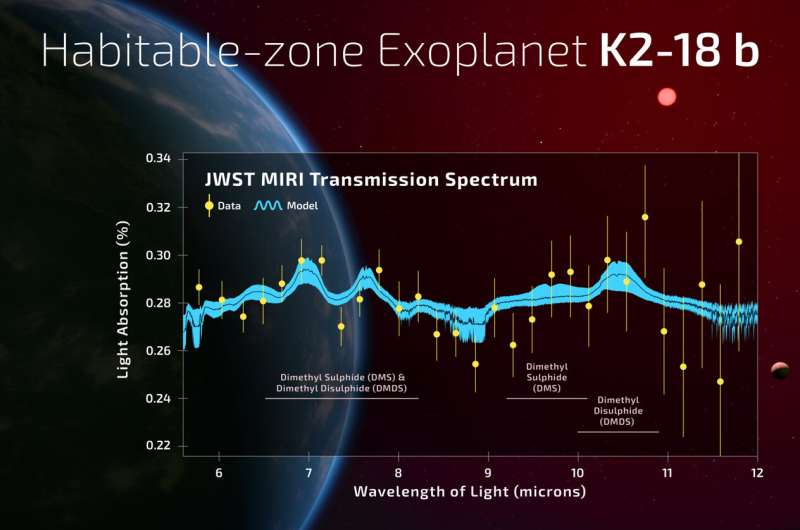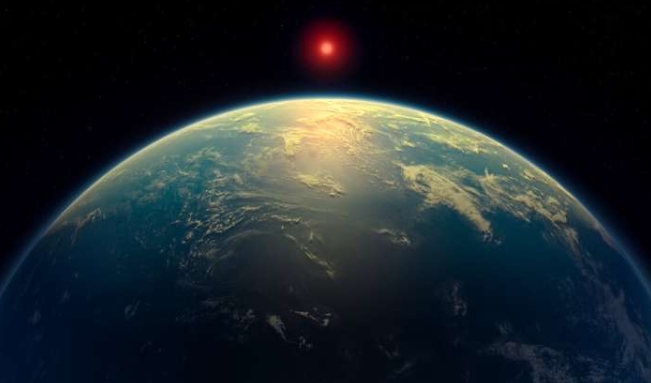
Recent research paper published by the American Astronomical Society – New Constraints on DMS and DMDS in the Atmosphere of K2-18 b from JWST MIRI – digs into the atmosphere of K2-18 b, which is the exoplanet people have been calling a “Hycean World,” meaning it might have a hydrogen-rich atmosphere and liquid water oceans. This study is based on data from JWST’s MIRI (Mid-Infrared Instrument), and it’s the first time we’ve gotten a mid-infrared transmission spectrum of a habitable-zone exoplanet like this.
The researchers looked at light passing through the planet’s atmosphere in the 6 to 12 micrometer range. That’s the mid-infrared, which can reveal a different set of molecules than what we would see in the near-infrared. The team used two different data processing pipelines – JExoRES and JexoPipe – to make sure the results weren’t just a fluke. Both data pipelines produced consistent spectra. The team ran multiple checks to rule out processing errors, including:
- How the light was extracted from the raw data
- Corrections for instrument nonlinearity
- Handling of noise, including time-correlated noise
- Spectral binning and resolution choices
- Limb darkening treatment during modeling
Sulfur Molecules Hint at Biological Activity
What’s really interesting is what they found: spectral features that point to dimethyl sulfide (DMS) and/or dimethyl disulfide (DMDS) in the atmosphere. Both of these are sulfur-containing molecules, and on Earth, DMS is mostly produced by marine life. It’s a byproduct of plankton and other microbes. DMDS is less well-known but can also come from biological activity.
There’s a catch, though, DMS and DMDS have overlapping features in the mid-infrared, so they can’t say for sure which one it is. It’s likely a mix. Statistically, they’re seeing a combined signal at about 2.9 to 3.2 sigma, depending on the model. Individually, DMS is showing up at about 2.9 to 3.0 sigma, and DMDS a bit higher at 3.0 to 3.2 sigma. (In astronomy, at least 5 sigma is required to make a solid detection). That’s strong enough to raise eyebrows but still not definitive.

Methane and CO2 Weaker in This Range
The team used the AURA retrieval framework to model what the planet’s atmosphere might look like at the terminator (the boundary between night and day on the planet). They tested models with a bunch of molecules, 20 in total, and the best fit included DMS, DMDS, methane (CH4), and carbon dioxide (CO2). That said, methane and CO2 weren’t clearly detected in this wavelength range; their signals just aren’t as strong here. But the upper limits are still consistent with earlier detections from near-infrared data.
Possible Biosignature
Now, about the potential for life: this is where it gets intriguing. DMS on Earth is only made by life, so seeing it (or something similar) out there opens the door to some big questions. The levels they’re seeing, which is more than 10 parts per million by volume are pretty high. If it’s biological, the source would have to be much more active than Earth’s oceans. They did consider abiotic sources like photochemical reactions or delivery from comets, but none of those really explain the concentrations unless something weird is going on.
Takeaway
The team is not claiming they’ve found life, just that this is a promising clue. But they’re also pretty clear that more work is needed. Better lab measurements of these molecules under exoplanet-like conditions (something like hydrogen-rich atmospheres, low pressure, high temperatures) would help a lot. Right now, they’re working with absorption data based on Earth-like settings, which might not hold up for a planet like K2-18 b.
Also, more JWST time could boost the signal and maybe even separate DMS from DMDS. That would be a big help in figuring out what’s actually there.
The paper was published in The Astrophysical Journal Letters on April 17, 2025, and it’s from a UK/US collaboration led by Nikku Madhusudhan. The work’s backed by UKRI and NASA and shows what we can do when we combine new instruments with careful modeling.
We might be seeing hints of a biological fingerprint on an exoplanet, not proof, but a solid lead. K2-18 b just became one of the most interesting places to watch in the search for life beyond Earth.
Source: Phys.org



